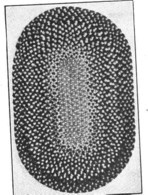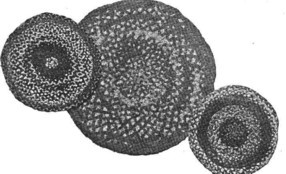RUG MAKING
"How can I utilize the contents of my rag bag?" is a question frequently asked, and any suggestions as to the solving of this problem are eagerly sought. Old pieces of linen, that have become worn and soft with age, can always be utilized by being torn into strips ad sewn together, and sent to the weaver to be woven up for bath mats and rag carpeting; but his is not the point at issue, as we want to know how we can use the rags ourselves, without the aid of a weaver or loom.
The joy of making a rag carpet is a real one. Try it and see how fascinated you will become when you find the work shaping itself under your hands. The pride of the oriental rug maker will be yours, only lacking oriental patience, you will rejoice in the rapidity with which the work nears completion.
Very often it is not possible for the homemaker to indulge herself in costly rugs and carpets, but to the woman who appreciates the true value of simplicity in house furnishings, those expensive articles become unnecessary in producing an altogether charming effect. She has found in her interesting experiments that it is far more refreshing and desirable to come into a room furnished with a blue-and-white rug of woven rags, than one which displays a gorgeous "Axminster" with staring flowers in yellow, pink and red, and a border of sprawling arabesques.
QUESTION OF COLOR
But remember that the color scheme must be carefully thought out' it would be a pity to neglect the infinite opportunity for harmony, and the dye pot is a faithful friend in bringing beauty out of a hodge-podge of miscellaneous odds and ends.
Flannel rags can be collected and dyed either blue, pink, green, or preferably, half the rags dyed one color, and the other half dyed in the same dye after it has been diluted with water, to make it a paler color; in this way a two-tone effect will be given. A pretty home-made rug may be made in this way.
Having collected about twenty-five pounds of flannel rags and having dyed them the desired shades they must now be torn into strips about an inch wide, and these must be neatly sewn together, overlapping about half an inch, so that the joining is strong. Now procure a length of clothesline rope, and commence to crochet the flannel strips over the rope. This is begun in the center, like any crochet wheel for a chair back. A large wooden crochet hook my be obtained from a needlework shop. The stitch of double crochet is used to cover the rope with the crocheted flannel. As you go along, the crochet is inserted into the previous row, so that the circle grows with every pull of the needle. In using two colors, the paler shade could be used until the circle is about a foot across. Then use the darker shade until you have gone five times around the rug. Return again to the paler color, repeating the alternate colors until the flannel is all used up, or the rug is the desired size, leaving the darker shade at the edge of the rug.
CHEAPNESS AND DURABILITY
These are very economical to make, and are very quickly done, and are among the most durable of any of the home-made rugs, as the rope makes such a hard, strong surface before it is covered with the flannel.
It is not always easy to amass enough flannel rags to go into this kind of rug making, but all kinds of things can be utilized for this purpose. Old chenille curtains which are not entirely worn out can be pulled apart and wound into balls. This material can be crocheted around the rug; it makes an excellent substitute for the flannel, and is even more quickly done. Old ingrain carpets can also be torn apart, and after having been thoroughly cleansed could be utilized in the same way as the chenille, a dye bath being resorted to if the colors are not what are wanted.
In every large town there are dealers who provide wefts and warps for weavers, and many of the wefts or fillings could be utilized for crocheting around the rugs. Sometimes they are made in many colors, other times they come in strong solid colors. Any of these can be used to crochet around the rope, as they can be bought for from five to twenty cents a pound, and a good-sized rug can be made for from fifty cents to a dollar.
THE BRAIDED RUG
 Then there is the fine old braided rug--the kind seen in nearly every New England home. Is there anything that lends to a room such an atmosphere of thrift, comfort and "hominess" as the braided rug? And still there are some parts of the country where the simple art is practically unknown.
Then there is the fine old braided rug--the kind seen in nearly every New England home. Is there anything that lends to a room such an atmosphere of thrift, comfort and "hominess" as the braided rug? And still there are some parts of the country where the simple art is practically unknown.
Brilliant contrast in these rugs are sometimes effective, if skill is used in arranging them but for everyday wear the monotone is advised. The prettiest ones have about three or four shades of one color, with perhaps black introduced as a contrast. Home dyeing usually comes out very uneven, and instead of detracting from the work, it adds to the beauty of the finished rug, as it produces a somewhat cloudy appearance, which makes it of interest . Some people add a piece of lack cloth pinked out at the edges to the to the rug when it is finished, to make it lap the floor. Many rugs are improved by a stripe of black appearing in the plait with two paler ones. This is especially attractive when it happens to be black velveteen.
A SIMPLE PROCESS
Now as to the actual making of the rugs. Directions are almost superfluous, the process is so simple. A little practice is necessary to find out what width the rags should be torn. A piece of old white muslin might have to be torn an inch and a half in width, while a strong piece of denim would only need to be half that width. The point is that the plait when finished must be of equal thickness, and these points are only learned by experience. The rags may be torn and plaited quickly, but the strips should be turned in while the rug is being plaited to insure perfectly smooth and finished work.
Most people do them in the rough-and-ready way, as they will not spend the time on the more finished article. The illustrations show both kinds of rugs. It is best to sew the plaits together as you go along and they should be tightly seamed on the wrong side with very small stitches. Four or five yards of strips can be plaited at once, providing one of the strips is quite short, as this prevents them from getting tangled up, which always happens if three long strips are plaited at once. Many people join the strips together as they go along, as they find it easier to work with them if they are not longer than half a yard, but these points are all decided by individual workers, according to their fancy.
A MATTER OF ECONOMY
 One feature of these rugs that appeals emphatically to the economical housewife is the opportunity they afford for using up otherwise worthless material. Old pieces of dress material, bits of ribbon, odd scraps of fine swiss, or even denim or cotton flannel, can any or all of them be utilized in the same rug, as the greater the variety in texture the more attractive the rug becomes. Care must be taken, however (as before hinted), not to mix too many colors, as they become a weariness to the eye if some restraint is not used in this direction.
One feature of these rugs that appeals emphatically to the economical housewife is the opportunity they afford for using up otherwise worthless material. Old pieces of dress material, bits of ribbon, odd scraps of fine swiss, or even denim or cotton flannel, can any or all of them be utilized in the same rug, as the greater the variety in texture the more attractive the rug becomes. Care must be taken, however (as before hinted), not to mix too many colors, as they become a weariness to the eye if some restraint is not used in this direction.
COTTON FLANNEL RUG
A very beautiful rug may be made from new cotton flannel. This can be bought very reasonable and it comes in old rose, blue and green. Five yards of this material will make a rug a yard across, and most artistic effects can be obtained by using new material. The shade of old rose harmonizes beautifully with some of the modern wall papers.
IMITATION INDIAN RUG
Cut wool or silk rags as for carpet weaving. Sew together several balls of solid colors, such as red and black. Sew all other rags "hit or miss". Crochet in Afghan stitch one strip of solid about half a yard wide, inserting crosses of contrasting color as you proceed. If knitted the middle strip might be in Roman stripe effect. Now make two strips about three inches wide, of "hit or miss", and sew on either side of the wide middle strip. For the outside edge have strips three or four inches wide, of solid color. No-fringe or finish of any kind is needed. A coarse bodkin threaded with the rags is used for sewing the strips together. The result is exceedingly attractive.
CHENILLE WOVEN RUGS
Take all your woolen rags and cut and sew as for a rag carpet. Wind every color separately. The borders are generally made of black and red rags, and sometimes a little green, and for the center any other color will do. It takes five pounds to one square yard; that is, a rug sixty and three-fourths inches by thirty-one inches will take seven to eight pounds, which makes a good-sized rug. For the border of the above size it takes one and one-half pounds of black and one of red. The price for weaving is about eighteen cents a square foot.
With so many different ways of utilizing rags and leftovers, surely we need no longer be perplexed with how to use up old materials, and we shall have found a means of adding to our homes useful and beautiful rugs, which can be glorified according to our resources and individual taste. The best way of using silk scraps is to cut and sew them as for a carpet (carefully blending the colors), and have them woven into curtains or portieres.